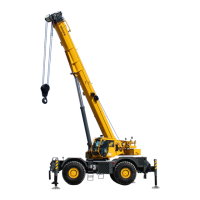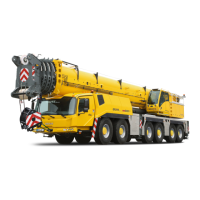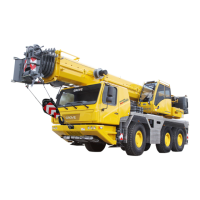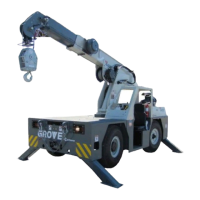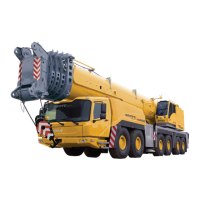HYDRAULIC SYSTEM TMS700E SERVICE MANUAL
2-22 Published 01-29-2015, Control # 512-01
PRESSURE SETTING PROCEDURES
Description
The hydraulic valves in the hydraulic system must be
properly adjusted to protect a component, a circuit, or a
system from over pressurization (relief valves) or to ensure
the components receive the appropriate pressure and flow
for proper operation. Most of the relief valves are located in
the directional control valves, but some are located in line
between components, while others are part of a component.
Maintenance
General
Relief valves are checked and adjusted by causing a given
circuit to reach its prescribed pressure limit (stall). At this
point the relief valve opens, returning hydraulic oil to the
reservoir. Hydraulic motor circuits may be stalled by
preventing rotation of the motor shaft prior to actuating the
control valve. Cylinder circuits may be stalled by extending or
retracting a cylinder to its limit of travel.
A reading of a pressure gauge placed in the proper line or
test port indicates when the relief valve opens. The gauge’s
needle climbs until it reaches the relief valve setting. Then
the needle stops climbing and fluctuates, showing the relief
valve is open and returning hydraulic oil to the reservoir.
Correct relief valve adjustment is mandatory if any hydraulic
circuit is to function properly. Settings must be within
tolerances. Only qualified technicians using the correct
equipment should make pressure adjustments when
pressure adjustments are needed.
The hydraulic system uses two valve banks. The hoist/lift/
telescope valve bank directs hydraulic oil flow for operation
of the main hoist, lift, and telescope circuits. RCL lockout
solenoids are located in the hoist up, lift down, and telescope
out functions. (If the crane has an auxiliary hoist, its auxiliary
hoist control valve will be in this valve bank.) A single section
valve bank serves the swing circuit.
The swing brake/armrest lockout valve (also called the swing
brake/armrest lockout manifold) directs hydraulic oil flow to
the swing brake release valve and pilot pressure for the
remote controllers.
The Hoist/Lift/Telescope directional control valve bank has
one main load sense relief valve limiting maximum operating
pressure of the components in related circuits. There are
also port relief valves in some circuits which limit operating
pressures as required by circuit design. The pilot generator
metering capsule located in the inlet section controls the pilot
pressure and flow to the swing brake/armrest lockout
manifold.
The following table and test procedures contain main and
port relief valve settings. If the pressure setting of the main
relief valve or a port relief valve is not within 3.45 bar (50 psi)
of the listed setting, adjustment is necessary.
NOTE: Use an accurate 0 to 345 bar (0 to 5000 psi)
pressure gauge when adjusting relief valves. For
most circuits, utilize the gauge ports on the circuit
valves or pumps. On a circuit without a gauge port,
locate a suitable pressure test port elsewhere in
the circuit.
To adjust a relief valve, turn the adjustment screw
(in to increase or out to decrease) until the proper
setting is reached.
Release the control lever after taking each reading
and while making adjustments. When the proper
pressure setting has been attained, tighten the
adjustment screw locknut and recheck the
pressure. It is possible that the setting may change
while tightening the locknut.
It is only necessary to hold hydraulic pressure long
enough (usually a few seconds) in the circuit to
gain an accurate reading. Do not overload the
hydraulic circuits for long periods of time.
If a question arises concerning pressure setting
values, always refer to the crane hydraulic
schematic supplied.
Reservoir oil temperature is to be 60° to 71°C (140°
to 160°F).
Preparation
1. Start and warm up the engine until the hydraulic oil
temperature reaches a minimum of 60° to 71°C (140° to
160°F).
CAUTION
Do not overtighten the adjustment screw or locknut.
Do not hold the relief valve open for more than one minute
at a time.
DANGER
Do not attempt to loosen the fittings in pressurized lines or
while the hydraulic pumps are in operation.
Reference Only
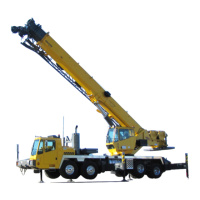
